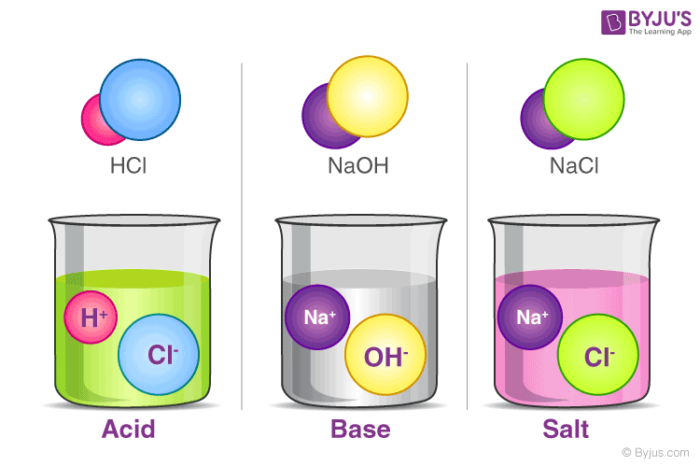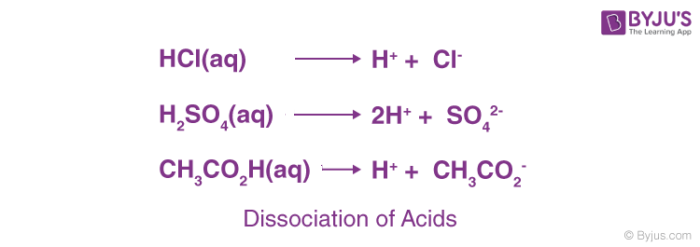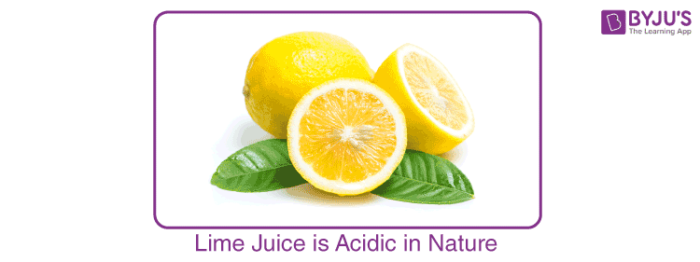Is Salt Basic Or Acidic
What are Acids, Bases, and Salts?
Many acids and bases occur naturally in nature, such as citric acid in fruits similar orange, lemon, etc, tartaric acid in tamarind, malic acrid in apples, and lactic acid in milk and milk products, hydrochloric acid in gastric juices.
Similarly, many bases are found such every bit lime water. We utilize many of these acids in our 24-hour interval-to-day life, such as vinegar or acetic acrid in the kitchen, boric acid for laundry, blistering soda for the purpose of cooking, washing soda for cleaning, etc.
Table of Content
- Definitions
- Recommended Videos
- Acids
- Bases
- Salts
- Frequently Asked Questions – FAQs
Many of the acids that we do not consume in the household are used in the laboratories and industries, which include an acrid such as HCl, H2And so4 etc, and bases such as NaOH, KOH etc. When these acids and bases are mixed in the right proportions, the neutralization reaction thus results in the formation of salt and water. Some naturally occurring salts found in nature include NaCl and KCl etc in seawater and natural rock deposits. In this section, nosotros will read more about acid, base, and table salt and their backdrop.
Definitions
- Acrid:- An acid is defined as a substance whose h2o solution tastes sour, turns bluish litmus cherry-red, and neutralizes bases.
- Base:- A substance is called base of operations if its aqueous solution tastes bitter, turns blood-red litmus blue, or neutralizes acids.
- Salt:- Salt is a neutral substance whose aqueous solution does not affect litmus.

Recommended Videos
Acids and Bases

Acids
The term acrid is derived from a Latin discussion 'acidus' or 'acere', which means sour. The most common characteristic is their sour gustatory modality. An acid is a substance that renders ionizable hydronium ion (H3O+) in its aqueous solution. It turns blue litmus paper red. These dissociate in their aqueous solution to form their constituent ions, as given past the following examples.


Based on their occurrence, they are divided into two types- Natural and mineral acids.
Natural Acids: These are obtained from natural sources, such as fruits and animal products. For e.k. lactic, citric, and tartaric acid etc.
Mineral Acids: Mineral acids are acids prepared from minerals. Examples are Hydrochloric acid (HCl), Sulphuric Acid (HiiAnd so4), and nitric acid (HNO3), etc.
Also, Bank check ⇒ Dilute Acids
Bases
The about common characteristic of bases is their bitter gustation and soapy experience. A base is a substance that renders hydroxyl ion(OH–) in their aqueous solution. Bases turn the color of ruddy litmus paper to blue.

The bases dissociate in their aqueous solution to grade their constituent ions, given in the following examples.

Salts
Salt is an ionic compound that results from the neutralization reaction of acids and bases. Salts are constituted of positively charged ions, known as cations, and negatively charged ions, known as anions, which can either be organic or inorganic in nature. These ions are present in a relative amount, thus rendering the nature of the common salt neutral.

The formation of common salt tin be seen from the chemical reactions shown in the equations below.

Oft Asked Questions – FAQs
What is table salt in acids, bases and, salts?
In chemistry, a table salt is a substance obtained by the reaction of an acid and a base. Salts are equanimous of positive ions (cations) of bases and negative ions (anions) of acids. The reaction of acrid and base is chosen the neutralization reaction.
Is NH4Cl a basic salt?
Ammonium chloride (chemical formula NH4Cl) is an acrid salt because it is a common salt of a stiff acrid (i.e. hydrochloric acid) and a weak base (i.e. ammonium hydroxide).
What are the 2 types of acids?
There are 2 basic types of acids organic and inorganic acids. Inorganic acids are sometimes referred to equally mineral acids. As a group, organic acids are generally non every bit strong as inorganic acids. The main departure between the ii is the presence of carbon in the compound; inorganic acids do not contain carbon.
Inorganic acids – Inorganic acids are oftentimes termed mineral acids. The anhydrous course may be gaseous or solid. An inorganic anhydride is an oxide of metalloid which can combine with water to form an inorganic acrid.
Case:
Sulphuric acid (HtwoSO4)
Phosphoric acid (H3PO4)
Nitric acid (HNO3)
Organic acids – Organic acids are corrosive and toxic. Corrosivity is a form of toxicity to the tissues that the acid contacts. Organic acids and their derivatives cover a broad range of substances. They are used in almost every type of chemical manufacture. Considering of the variety in the chemic structure of the members of the organic acid group.
Example:
Acerb acid
Citric acrid
Formic acid
Is table salt basic or acidic?
The salt is basic only when it contains a weak acid conjugate base. For case, sodium chloride contains chloride (Cl-), the conjugate base of HCl.
What happens when salt reacts with HCl?
When an acrid reacts with metallic, a salt and hydrogen are produced:
acid + metallic → common salt + hydrogen
The salt that is produced depends upon which acrid and which metal react.
Sodium metal reacts with hydrochloric acid which produces hydrogen gas and sodium chloride.
2Na(s)+2HCl(aq)→2NaCl(aq)+H2(thou)
To learn more nigh acids and bases and neutralization reactions, the pH scale and other related topics, come register with BYJU'S and download BYJU'S – The Learning App.
Is Salt Basic Or Acidic,
Source: https://byjus.com/chemistry/acids-bases-salts/
Posted by: childsucipt.blogspot.com


0 Response to "Is Salt Basic Or Acidic"
Post a Comment